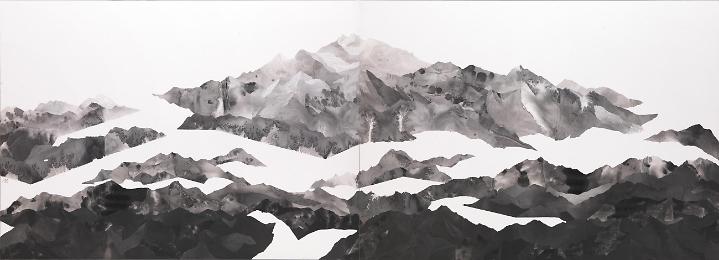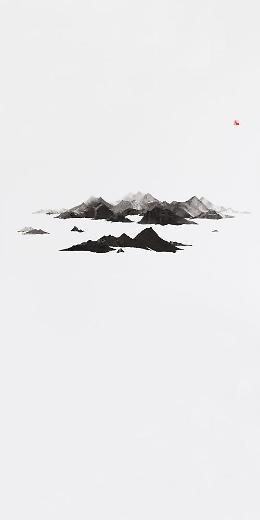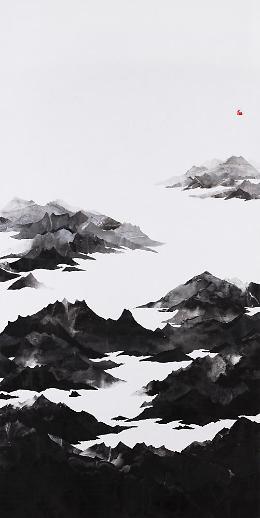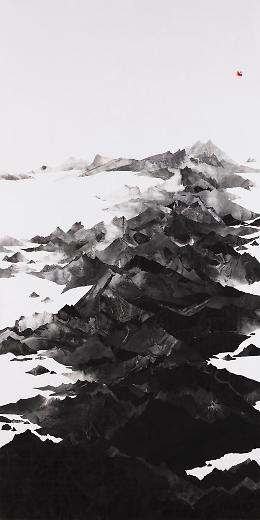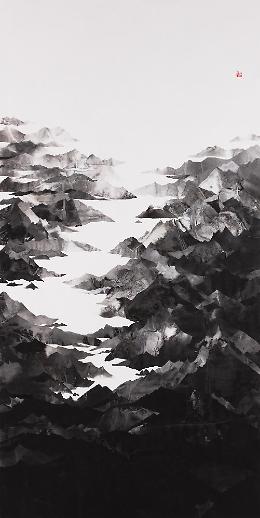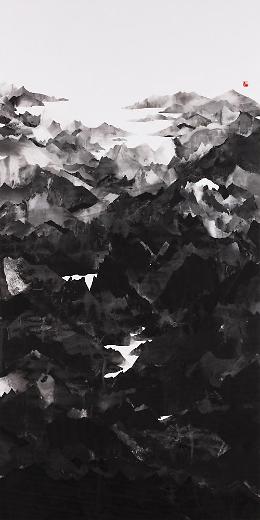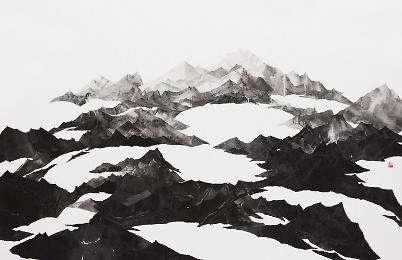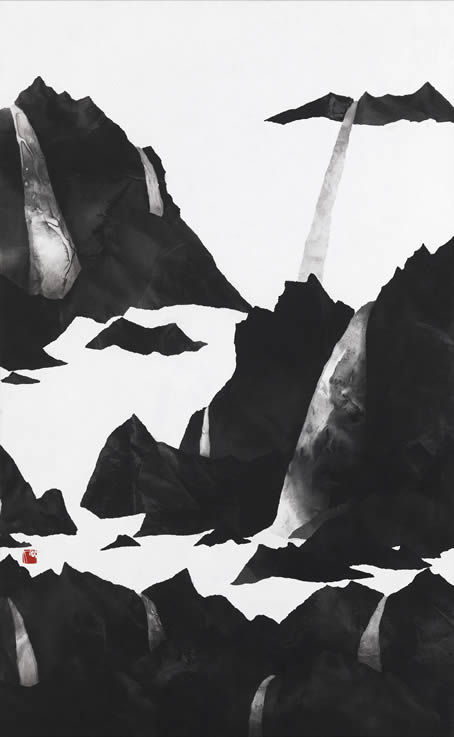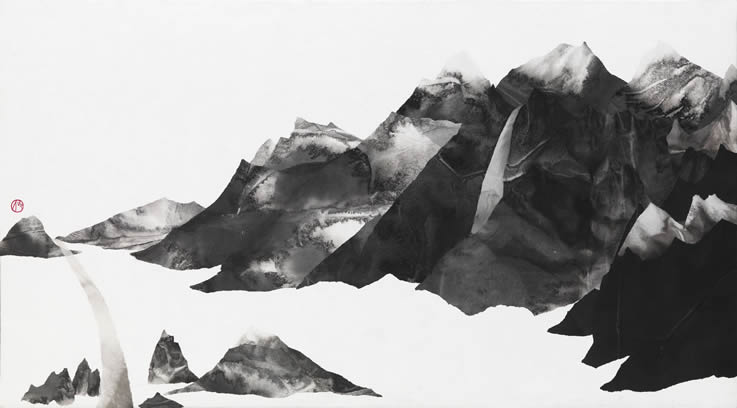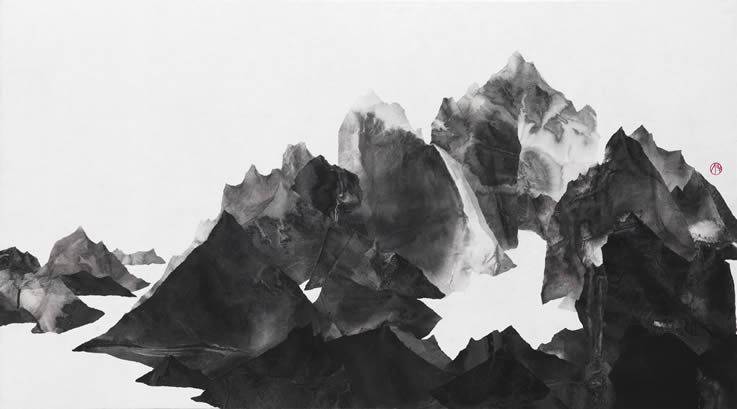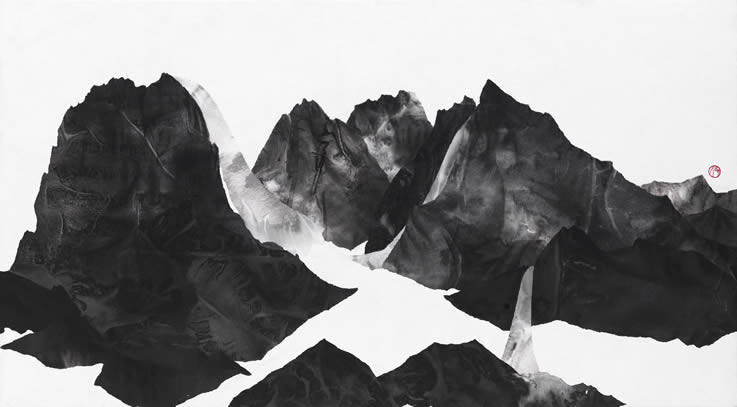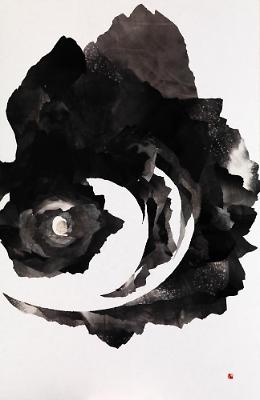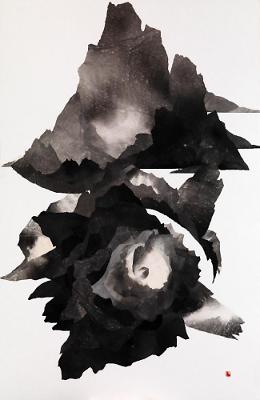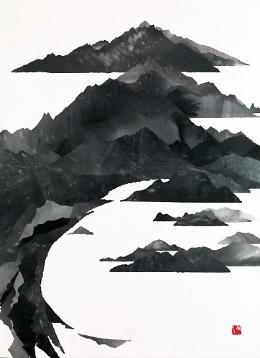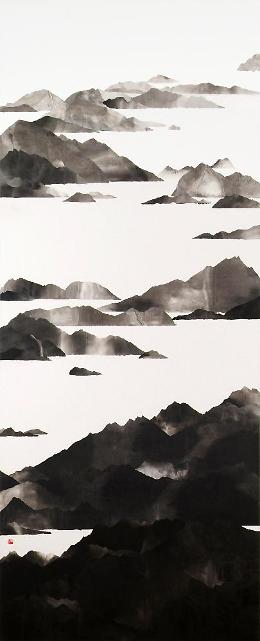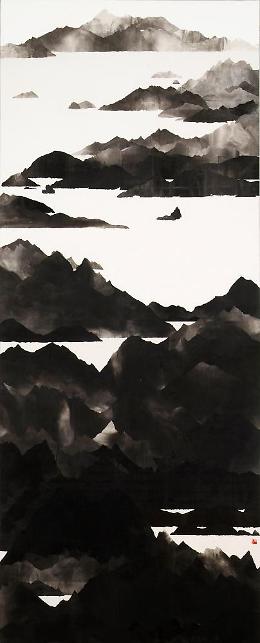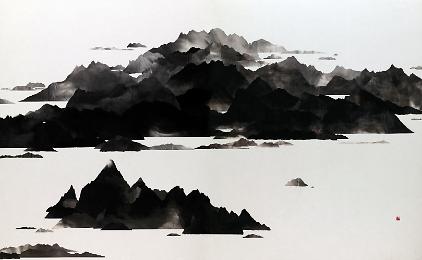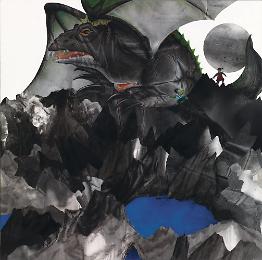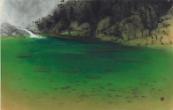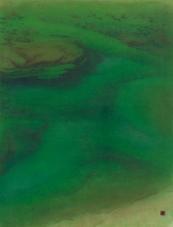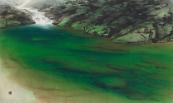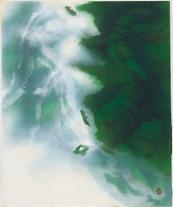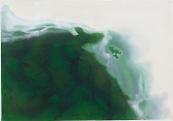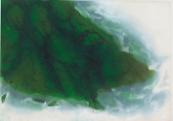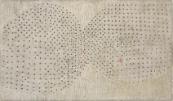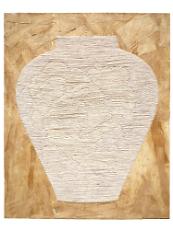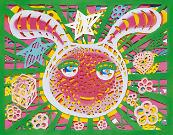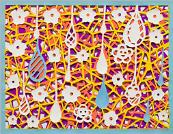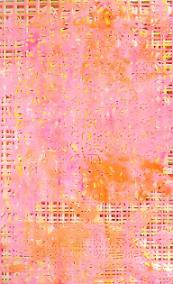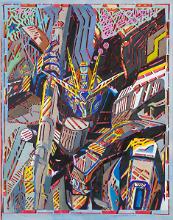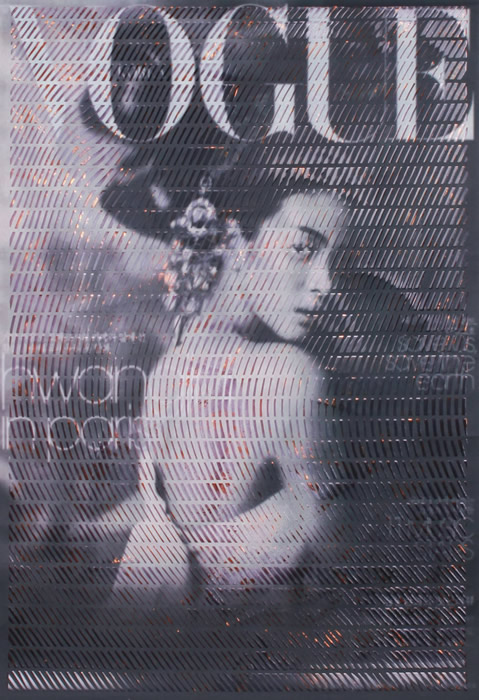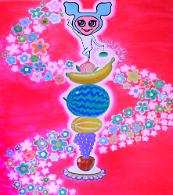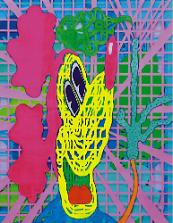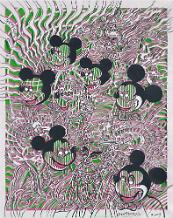전통수묵과 현대적 운필의 조화
국립현대미술관 학예연구관 장 영 준
미술사가 조지 로울리는 “동양예술의 창조는 정신과 물질의 상상적 결합의 산물로서 예술가 자신이 창조자로서 간파하는 안목과 스스로 체험한 경험이라고 하는 원료 및 자신이 창작의 주체로서 반영하려고 하는 궁극적인 정신의 종류에 따라 달라진다” 고 말한 바 있다. 종교와 마찬가지로 예술은 외형으로 드러나는 표피적 현상보다는 삶의 내면을 중요시 하던 까닭에 예로부터 정신적 깊이를 최상의 경지로 인식해 온 동양의 회화예술은 이러한 철학과 문화적 배경을 토대로 성장해 왔으며 내면에 존재하는 정신적 감정과 다양한 조형 이론에 대한 깊이는 현대 미술계에서도 그 가치가 새롭게 인식되고 있다. 따라서 자연의 형상에서 그 근본을 찾고 정신을 유출해 내는 산수화 장르와 같은 전통 한국화 작업은 자연의 원리를 뼈대로 하는 동양회화의 철학적 인식 속에서만 이해 될 수 있을 것이라 생각된다. 예로부터 동양에서는 회화 예술을 가리켜 신비한 대자연의 이치를 인간의 진의(眞意)와 기운(氣韻)을 통하여 그 본질을 밝혀내는 것이며 그리하여 자연의 참모습을 작가의 마음속에 내재된 신운(神韻)으로 해석하는 예술의 한 장르로 여겨져 왔다. 더욱이 동양화는 담백한 표현 양식과 신비스러우면서도 현학적(玄學的)인 먹색의 조화 등 동양인의 정서와 체질에 알맞은 재질과의 일체감으로 인하여 그 정신적 깊이를 가늠하기 힘든 상징적 표현의 영역으로 인식되어 왔던 까닭에 생략과 함축, 은유적 의미가 강조되어 왔던 것이다.
요즘 주목받고 있는 청년작가 중 한 사람인 설박은 그 동안 자연의 이미지와 정서에 대한 감흥을 수묵을 위주로 한 전통 필법과 현대적 조형 감각을 혼용하여 꾸준히 발전시켜 오고 있는 현대 수묵화 작가라 말 할 수 있다. 처음 수묵화의 묵필법을 익히는 것에서 시작하여 점차 산수화, 문인화 장르에 이르기까지 운필의 영역을 넓혀 온 작가는 최근에 거대한 포치의 대자연을 그리는 현대 수묵 산수화에 그의 시각을 집중하고 있다. 초기 사실적인 묘사 방식에서 출발하여 점차 간결한 포치와 반추상적 표현 형식을 통하여 대자연의 정서에 주목한 작가의 작품 세계는 전통 동양 회화의 서정적 표현에 수묵화의 사유적 미감을 조화시키는 독특한 시각을 보여주고 있는데, 특히 표현대상의 내면에 존재하는 정체성을 강조하기 위해 꼴라쥬 형식의 체기법과 음영법을 혼용한 간결한 형태와 절제된 먹색, 섬세한 필치를 반복적으로 사용하고 있다. 최근에는 여기에 사생 작업에서 비롯된 상상력을 가미한 다양한 구도를 활용하여 보다 더 생동감 넘치는 화면을 보여주기도 한다. 더욱이 작가는 화면 안에 기운생동한 자연의 미감을 격조있게 전달하고자 간결한 윤곽선과 먹을 중첩시켜 입체감을 강조하는 응양의 표현기법을 즐겨 사용하고 있는데 이런 작품의 특성은 그의 작가적 개성을 엿볼 수 있는 중요한 근거가 되고 있다.
<어떤 풍경> 등과 같은 그의 수묵산수화풍의 작품들은 이런 작가의 성향을 잘 드러내고 있는 대표적 작품들로서 특히, 대표적 작품 중 하나인 <풍경을 담다>는 축양된 구도 위에 담백한 먹색과 필치를 조화시킨 작가의 표현경향이 잘 드러난 의미 있는 작품이라 말 할 수 있다. 동양화의 전통 구도법인 심원법이나 평원법 구도를 활용하여 남도의 다도해를 그린 섬 풍경과 같은 작품 소재들은 오랫동안 우리 전통예술의 회화적, 음악적, 문학적 표현 소재로 애용되어 온 상징적 존재로서 작가는 현대 수묵화를 통해 자연에서 느낄 수 있는 회화적 감성을 그만의 스토리로 엮어 내고 있는 것이다. 예로부터 묵필의 전통 매재는 기를 무시한 정신이나 정신이 무시된 기의 현상적 해석보다 기운생동(氣韻生動), 전이모사(轉移模寫) 등 동양화 고유의 화론에 입각한 정신세계와 회화의 본질을 구현하는데 초점을 맞추었다. 따라서 요즘 수묵화 작가들이 동양 회화의 진수를 깨닫기 위해서는 지필묵에 대한 고답적 관념을 깨뜨릴 수 있는 실험적이고, 진취적인 자세를 갖추어야 하며 이런 현상들이 보편적으로 수용될 때 비로소 글로벌화 되는 시대와 급변하는 변화의 시대에 잘 적응 할 수 있을 것으로 여겨진다.
평소 작가는 작업의 근원적 시각을 대자연의 기운생동(氣韻生動)한 미감에 두고 있으며, 특히 한국적 정서와 향토적 미감, 우리 전통적인 표현 양식인 문인화, 서예 분야와 함께 서구 현대 회화에 이르기까지 관심을 가져 왔다고 말했는데 초반 그의 작업들이 사물을 섬세하게 묘사하는 사실적 회화경향에서 시작되었다면 2000년대 후반 이후에는 이런 흔적들이 사라지고 단순화 된 배경 위에 사물의 이미지를 입체적이고 간략한 형태로 표현하는 사의적 정신과 조형의 흐름을 강조하고 있는 데서 그 이유를 찾아 볼 수 있을 것 같다. 그런 의미에서 작가는 먹의 고유한 특성인 직관과 함축미를 바탕으로 종이의 수용성과 붓의 활달한 운필의 기세를 함유하는 동양회화 예술의 근본인 수묵화를 삼절(三節)의 의미와 함께 잘 이해하고 있는 것으로 여겨진다. 작품 <어떤 풍경> 연작 시리즈는 그의 이러한 현대적 표현감각과 묵필의 조형적 특성을 잘 보여주고 있는 것으로 사물의 이미지를 전통회화와 현대회화의 연결선상에서 재해석하려는 향후 그의 작업방향을 유추해 볼 수 있는 중요한 작품들이다. 2011년 중국 북경 T Art Center 갤러리에서 초대 개인전을 연 이후 변화된 화면에서 드러나는 먹색의 농담조절과 간결한 운필의 운용은 작가의 또 다른 시각의 변화로, 이것은 동양회화의 본류인 중국 화단으로부터 받은 정신적 충격에서 비롯된 것이라 말할 수 있는데 그의 작품에서 파악되는 먹의 습윤하고 정갈한 의취(意趣)의 선염(渲染)기법만 하더라도 한지나 화선지와 같은 독특한 수용성 매재를 통해 그 특색이 잘 나타나고 있음을 알 수 있다. 이러한 동양의 묵필 재료들은 서화의 본질을 직관적으로 파악하기에 가장 적합한 재료로서 작가는 이런 전통재료들을 현대적 시각에 걸맞게 적절히 활용하면서 변화시키고 있는 것이다. 사실 동양철학의 정신적 미의 개념과 서양철학의 추상적 미의 개념이 차이점을 보인다 할지라도 본질적인 정체성 측면에서 보면 그것이 자연과 인간의 존재로부터 생성되는 까닭에 현대미술의 입장에서 보면 큰 차이가 없다. 글로벌화된 현대 사회에서는 일정한 양식과 사조가 파괴되고 온 세계가 인터넷으로 곧바로 연결되는 새로운 시각과 사고를 요구하는 달라진 시대다. 그런 연유로 비록 현대문화의 급격한 흐름 속에서 무시되고 소홀하게 취급 받는 전통적인 것, 토속적인 것일지라도 잘 가꾸고 계승발전 시키는 것이 미래의 우리에게 가치 있는 것이다. 청년작가 설박이 보여주는 수묵 산수화가 한국화를 포함한 동양회화의 중요성을 오늘의 시점에서 강조하는 또 하나의 자기주장이라면 우리 것에 대한 보다 깊은 주체적 성찰과 연구가 뒤따라야 하는 것은 이런 이유에서일 것이다. 따라서 현대회화의 흐름을 다각적으로 조망하여 수묵화를 한국적 정체성을 간직한 한국 현대미술의 한 장르로 부각시킬 수 있을 때 작가가 얘기하고자 하는 한국화의 세계화, 곧 전통 동양회화의 독자적 가치와 중요성이 세계미술문화를 주도해가는 또 하나의 중심축 역할을 할 수 있을 것이다.
The Harmony of Traditional Ink Wash Painting and Contemporary Brush Strokes
by Chang Young Jun
Senior Curator
National Museum of Contemporary Art, Korea
Art historian George Rowley once said “Asian art was created as the product of the imaginative marriage of mind and material, that changes according to the insight possessed, the ingredients of direct experiences, and the type of mind the artist, as the creator, wishes to assign.”
Much like religion, art values the internal depth of life with more weight than the visibly external appearances. It is for this reason the modern art currents today are focusing their attention to Asian painting ? having developed under such philosophical and cultural backgrounds to revere the depth of mind as the paramount quality ? newly recognizing the value of the internal psychological emotions and the various sculptural theories it possesses.
Landscape painting finds its basic identity and creates an inspirational mindset from forms of nature. Therefore as an art of this genre, it seems the works of traditional Korean landscape paintings, can only be understood within the framework of the philosophical awareness of Asian paintings, that stem from the fundamentals of nature. Since ancient times the East have referred to landscape painting as an artistic genre of interpretation. It was believed that through the genuine intentions and the energy force of humans, the secrets of Mother Nature’s mysteries are revealed, and that landscape painting was the interpretation of nature’s true form, seen through divine spirit of an artist’s mind.
As the result of the unification of its simplistic representation and the use of materials suitable to Asian sentiments and constitution like the mystical and abstruse color black, Asian art has been understood as an arena of symbolic expression with imponderable inner depth. And it is due to this nature that emissive, comprehensive and poetic meaning has been accentuated in this art form.
A young woman at the center of attention lately is Sul Park, a contemporary ink wash artist that has been steadily building up a technique that expresses natural imagery and inspirations of sentiment and emotion by combining traditional brush strokes of mainly ink wash painting and contemporary formative art styles. She began with acquiring basic brush stroke skills, moving on to landscape painting, and even muninhwa (a genre of Korean paintings done by non-artists, such as cultured scholars, aristocrats, etc to express their intentions) which broadened the spectrum of her brush stroke techniques.
Recently Park has been focusing on contemporary ink wash landscapes and producing oversized grand landscapes. While the artist may have had her roots in the realistic depiction approach, she soon began focusing on the emotional depiction of Mother Nature as oversized laconic works using semi-abstract expressions. Her artistic scope combines the poetic delivery of Asian painting with the introspective aesthetic sense of ink wash art, giving birth to a truly unique perspective. By using stereology and shadowing techniques in a collage format, drawn in a laconic manner with the reserved color black in repetitive, delicate and detailed strokes, Park accentuates the inherent internal identity of the subject matter. In her recent works, she applies various sketches originating from imaginative compositions to produce a dynamic display.
The artist attempts to capture nature’s vital and energetic beauty in a distinguished manner by often adopting a light and dark expressive technique to emphasize volume, used together with black ink and short edges. Such unique factors of Park’s work serves as crucial evidence in assessing her idiosyncratic artistic personality. Park’s ink wash landscape pieces like A Certain Landscape aptly illustrates her artistic inclinations while in another one of her representative works Capturing a Scene, the marriage between the simple color black and stylish strokes in a simplified composition shows well his characteristic expressive style.
Often expressed using traditional compositional techniques such as shimweon (bottom to top view) pyeongwon (leveled view) rule of Asian Ink Painting, the archipelago of the Korean Namdo region has long since been a sought after symbolic subject of paintings, music, and culture of traditional Korean arts. Through the medium of contemporary ink wash paintings, the artist tries to express in her own terms, the illustrative emotions emanating from nature. Since the early days, the classic central idea of ink painting was less about the phenomenal interpretation of mind without chi or chi without mind, and was more focused on the mindset of Asian painting theories such as Giwoonsaengdong (the exertion of inherent vital energy of literal or artistic works) and Jeonyimosa (transient simulation) as well as actualizing the fundamentals of painting itself. It is necessary for ink wash painters of today to adopt an experimental and progressive attitude in order to break the walls of abstruse customs of paper and brush and understand the true value of Asian painting. It is when such practices are accepted as common place that artists can skillfully adapt to a fast changing global environment.
Park’s work may have started with painting trends of realistic depiction of objects, but it took a clear turn away from such style after 2000, when she began to express laconic, multi-dimensional images of objects atop simple backgrounds, emphasizing on the private psyche and the fluidity of models. It is from her work we can understand the reason why her usual artistic perspective is focused on the beauty of Mother Nature’s energetic vitality and why she has expressed special interest in the Korean sentiment and scenic beauty, muninhwa, a traditional Korean method of expression, calligraphy, and even Western contemporary painting. In that sense, it is quite clear the artist understands well ink wash painting, the root of Asian art, along with its three main elements ? the inherent intuitive and comprehensive nature of the black ink, the flexibility of paper, and the dynamic vigor of the brush.
Park’s serial piece Certain Landscape appropriately demonstrates her modern style of expression and characteristic depiction of objects with the brush. They are important works that foreshadow her artistic intensions for the future in her attempts to reinterpret the image of an object within the common realms of traditional and contemporary painting. The changes observed in her short brush stroke style and the use of different shade values following his solo exhibition at the T-Art Center of Beijing in 2011 are evidence to another change in Park’s artistic perspective, a psychological shock of sorts influenced by her exposure to the Chinese painting community, the mainstream of Asian painting. Her intentional preference towards the saturated and elegant expression of the black ink using the seonyeum technique (painting on a wet surface) is well communicated through the use of distinctive and flexible mediums such as hanji (traditional Korean paper handmade from mulberry trees) or hwaseunji (a type of hanji that absorbs and bleeds ink well). The materials of Asian ink painting are the best fit to intuitively understand the true nature of words and pictures, and the artist aptly utilizes and modifies these materials to fit the modern perspective. The concept of mental beauty of the East and the concept of symbolic beauty of the West may have their differences but in reality, in terms of fundamental identities from the perspective of contemporary art, they are not much different from each other as they both originate from nature and man.
With the entire world connected via the internet throughout, the globalized modern society of today continually breaks set structures of style and trends, and demands new ideas and perspectives. For this reason, it is important and will be of value to our future, to inherit, nurture, and develop traditional and indigenous treasures, even if they may be neglected and dismissed in these fast changing modern times.
If at this point the ink wash paintings of the young artist Sul Park can be seen as a self-proclamation about the importance of Asian and Korean painting, it is precisely for this reason that profound research and introspection of identity is needed for all things ours. Therefore following the multi-angled evaluation of contemporary art trends, the time that ink wash painting can be magnified as a genre of Korean contemporary art - with its Korea identity intact ? is when the globalization of Korean painting suggested by Park, the independent value and importance of traditional Asian painting, will be able to take lead of the international art culture as the central axis.

 작품을 클릭하시면 큰 화면으로 감상하실 수 있습니다.
작품을 클릭하시면 큰 화면으로 감상하실 수 있습니다.







